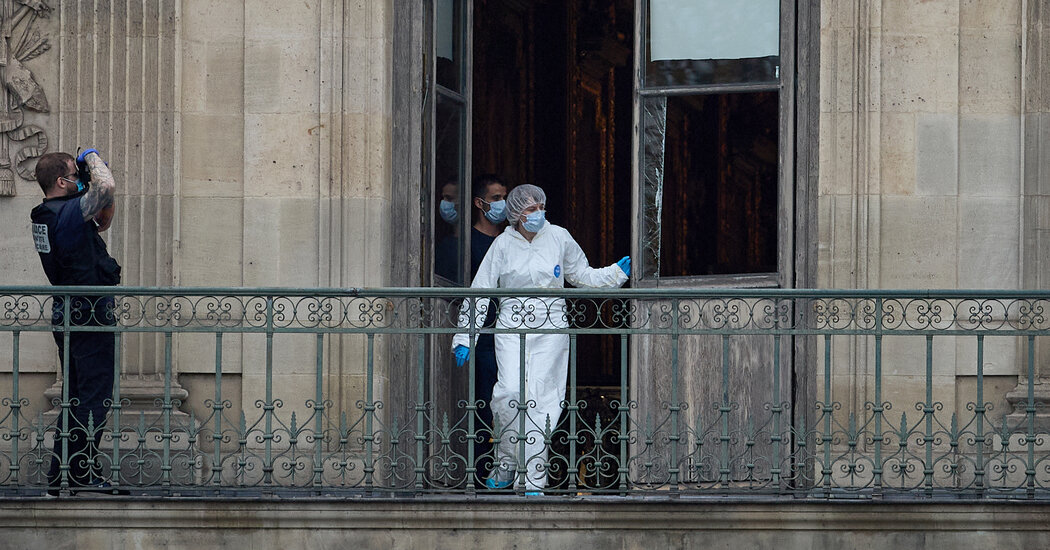Copyright The New York Times

It took just eight minutes. Thieves broke into the Louvre on Sunday while tourists were perusing art. They made off with jewelry said to be of incalculable worth. My colleagues have been reporting on one of the most dramatic heists this century — how thieves pulled it off, why they did it and what precedents there are for this kind of brazen burglary. Here’s what we know. How they did it With a truck, a ladder, a disc cutter and some scooters. At 9:30 a.m., the thieves parked a truck under the windows of the Apollo Gallery. Then they climbed up an electric ladder from the back of the truck. (This truck-mounted ladder — a monte-meubles — may look odd or suspicious to non-French people, but it’s a pretty common sight on the streets of Paris, where it is used to lift bulky furniture through apartment windows.) To break into the gallery, they carved the glass with the disc cutter, setting off the security alarm. They threatened guards with the disc cutter and smashed two display cases while the Louvre’s staff members evacuated the museum. The robbers grabbed a royal sapphire necklace, a royal emerald necklace and a diadem worn by Empress Eugénie, the wife of Napoleon III. See their entire haul here. By 9:38, the thieves had mounted two high-powered scooters waiting for them outside. They drove away. Why they did it In that sense, the Louvre heist wasn’t really art crime, Vernon Rapley, a former leader of the London police force’s art squad, told my colleague Alex Marshall. It was “commodity theft.” Commodity thieves don’t worry about leaving some valuable pieces behind. The robbers at the Louvre didn’t bother with high-profile and easily identifiable pieces, like the Regent and Sancy diamonds, which would have been tricky to resell, even broken up. The robbery has raised questions about whether the Louvre could have been better protected. Labor unions at the museum said they had previously warned about technical and staffing issues, particularly among security guards. The World is our new morning newsletter about international news. Subscribe below to get it in your inbox each weekday. Early yesterday morning, people around the world struggled to check in for flights, watch Hulu, wire money, play Fortnite, order McMuffins and, most important, read The Times. (Unbiased!) Our publishing software wouldn’t work, and one of my London colleagues, Claire, trekked to another colleague’s house to send Monday’s newsletter. It doesn’t take much to crash the internet anymore. In this case, it was a glitch at Amazon Web Services, the world’s largest cloud provider, at a site in Northern Virginia. Instead of managing their own servers, most businesses pay cloud companies like Amazon to do it. Much of the modern internet lives and dies by AWS; it supports more than a third of the 100,000 busiest websites in the world. Yesterday’s disruption was the biggest digital-services outage since last summer, when a buggy software update from the cybersecurity firm CrowdStrike grounded planes and shuttered businesses for days. The fallout then wasn’t limited to tech workers. Travelers missed trips; retailers couldn’t make sales; bystanders couldn’t call 911. Companies lost billions. Meltdowns like these are possible only because the internet is more interconnected than ever. Thousands of companies use the same third-party programs (like CrowdStrike) and send their data to the same third-party cloud providers (like AWS). “People have been putting more and more of their eggs in the same basket,” said Mehdi Daoudi, founder of the web-monitoring company Catchpoint. Feast your eyes: These are the best pastries in New York. Travel tips: Marie Kondo, the master of tidying up, has advice on how to pack a suitcase. Stargazing: The Orionids meteor shower peaks tonight. Prodigy: Daniel Naroditsky, a chess grandmaster who was the No. 1-ranked player in the U.S. when he was 9 years old, has died at 29. In 2022 he created an interactive puzzle for The Times, called “Chess Replay,” that dropped players into historic matches. Play it here.



